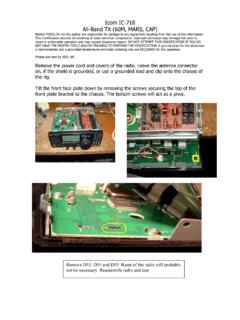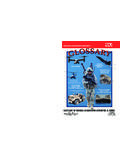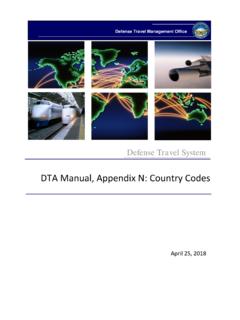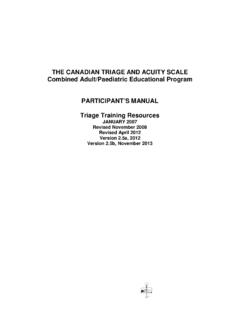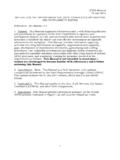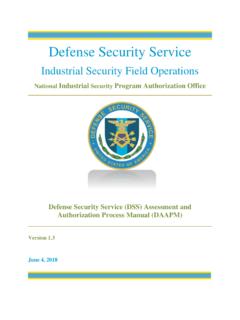Transcription of DEPARTMENT OF DEFENSE INTERFACE STANDARD
1 NOT. MEASUREMENT. SENSITIVE. MIL-STD-188-141B. 1 MARCH 1999. SUPERSEDING. MIL-STD-188-141A. 15 SEPTEMBER 1988. DEPARTMENT OF DEFENSE . INTERFACE STANDARD . INTEROPERABILITY AND PERFORMANCE STANDARDS. FOR MEDIUM AND HIGH FREQUENCY. RADIO SYSTEMS. AMSC N/A AREA TCSS. DISTRIBUTION STATEMENT. : Approved for public release;distribution unlimited. MIL-STD-188-141B. FOREWORD. 1. This STANDARD is approved for use by all Departments and Agencies of the DEPARTMENT of DEFENSE (DoD). 2. In accordance with DoD Instruction , it is DoD policy that all forces for joint and combined operations be supported through compatible, interoperable, and integrated Command, Control, Communications, and Intelligence (C3I) systems.
2 Furthermore, all C3I systems developed for use by forces are considered to be for joint use. The director of the DEFENSE Information Systems Agency (DISA) serves as DoD's single point of contact for developing information technology standards to achieve interoperability and compatibility. All C3I systems and equipment shall conform to technical and procedural standards for INTERFACE , interoperability, and compatibility, as recommended by DISA. 3. MIL-STDs in the 188 series (MIL-STD-188-XXX) address telecommunication design parameters based on proven technologies.
3 These MIL-STDs are to be used in all new DoD. systems and equipment, or major upgrades thereto, to ensure interoperability. The MIL-STD-188. series is subdivided into a MIL-STD-188-100 series, covering common standards for tactical and long-haul communications; a MIL-STD-188-200 series, covering standards for tactical communications only; and a MIL-STD-300 series, covering standards for long-haul communications only. Emphasis is being placed on the development of common standards for tactical and long-haul communications (the MIL-STD-188-100 series).
4 The MIL-STD-188 series may be based on, or make reference to, Joint Technical Architecture, American National Standards Institute (ANSI) standards, International Telecommunications Union - Telecommunication Standardization Sector (ITU-T) recommendations, North Atlantic Treaty Organization (NATO) Standardization Agreements (STANAG), and other standards wherever applicable. 4. This document contains technical standards and design objectives for medium- and high-frequency radio systems. Included are: (1) the basic radio parameters to support both conventional and adaptive radio communications; and (2) technical parameters for automatic link establishment (ALE), linking protection, and other advanced adaptive features and functions.
5 5. The technical parameters in certain identified paragraphs have not (as of the date of publication) been verified by testing or implementation. These parameters have, however, been subjected to rigorous simulation and computer modeling. The DoD working group and the Technical Advisory Committee (TAC) are confident that these features, functions, and parameters are technically valid. The un-tested portion of the technology are marked (NT). following the title of each paragraph containing un-tested material. 6. Users of this MIL-STD should note that there is no proprietary or otherwise restricted use material in this document.
6 This document is for unrestricted DoD, federal, and industry use. i MIL-STD-188-141B. TABLE OF CONTENTS. PARAGRAPH PAGE. 1. SCOPE..1. Applicability..1. Application guidance..1. 2. APPLICABLE Government documents..1. Specifications, standards, and Other Government documents, drawings, and publications..2. Non-Government Order of precedence..3. 3. DEFINITIONS..3. Terms..3. Abbreviations and 4. GENERAL REQUIREMENTS..5. Equipment Basic HF radio parameters..6. Equipment operation Baseline mode..7. Push-to-talk operation.
7 8. ALE mode..8. Anti-jam (AJ) mode..8. Linking protection (LP)..8. INTERFACE Electrical characteristics of digital Electrical characteristics of analog interfaces..9. Modulation and data signaling rates..9. NATO and Quadripartite interoperability requirements..9. Single-channel communications Maritime air communications High-performance HF data Adaptive communications..10. Linking HF data link protocol..11. Networking Indirect calling and Network management..11. Application protocols for HF radio networks..11. ii MIL-STD-188-141B.
8 TABLE OF CONTENTS. (continued). PARAGRAPH PAGE. 5. DETAILED REQUIREMENTS..13. Signal and noise Common equipment Displayed Frequency Frequency accuracy..14. Phase stability..14. Phase Overall channel Absolute Transmitter characteristics..19. Noise and distortion..19. Spectral purity..21. Carrier suppression..23. Automatic level control (ALC)..23. Attack and release time delays..25. Signal input INTERFACE characteristics..25. Transmitter output load Receiver characteristics..27. Receiver rf characteristics..27. Receiver distortion and internally generated spurious outputs.
9 28. Automatic gain control (AGC) characteristic..29. Receiver linearity..29. INTERFACE Basic ALE (2G)..30. 3G ALE..30. ALE control functions (orderwire functions)..30. Networking Network management..30. HF application Data link protocol..31. Anti-jam capability..31. Automatic repeat request (ARQ) iii MIL-STD-188-141B. TABLE OF CONTENTS. (continued). PARAGRAPH PAGE. 6. Intended use..31. Interaction Issue of Subject term (key word) International standardization Electromagnetic compatibility (EMC) TABLES. TABLE I. Relaying alternative notes.
10 13. TABLE II. TABLE III. Out-of-band power spectral density limits for radio transmitters..21. TABLE IV. Interaction matrix: General FIGURES. FIGURE 1. Physical layer with transceiver and modem elements..7. FIGURE 2. Radio subsystems INTERFACE FIGURE 3. Relaying FIGURE 4. Phase noise limit mask for fixed site and transportable long-haul radio transmitters. 15. FIGURE 5. Phase noise limit mask for tactical radio transmitters..16. FIGURE 6. Overall channel response for single-channel or dual-channel equipment..18. FIGURE 7.

